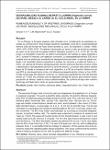Mostrar el registro sencillo del ítem
Degradabilidad ruminal de pasto llorón (Eragrostis curvula (schrad.) nees) a lo largo de su ciclo anual en La Pampa
Rumen degradability of weeping lovegrass (Eragrostis curvula (schrad.) nees) along the annual cycle in La Pampa
| dc.contributor.author | Stritzler, Néstor Pedro | |
| dc.contributor.author | Rabotnikof, Celia Mónica | |
| dc.date.accessioned | 2020-10-23T00:17:49Z | |
| dc.date.available | 2020-10-23T00:17:49Z | |
| dc.date.issued | 2013 | |
| dc.identifier.uri | https://repo.unlpam.edu.ar/handle/unlpam/6121 | |
| dc.description.abstract | En La Pampa, la forrajera perenne más utilizada como complemento de pastizales naturales es el Pasto llorón. Este trabajo estudió la solubilidad inicial (SI) y la degradabilidad efectiva (DE) del forraje de Pasto llorón durante su ciclo. Se realizaron 5 cortes: 16/06; 14/01; 4/03; 15/05; 01/07. El material, fraccionado en lámina y tallo, se incubó en bolsitas de nylon, en el rumen de 3 novillos Hereford fistulados durante 3, 6, 9, 12, 24, 48, 72 y 96 horas. La solubilidad inicial (SI) se estimó sumergiendo las bolsitas en agua destilada a 39ºC, durante 15 minutos, con agitación constante. La degradabilidad efectiva (DE) de la materia seca se estimó por sumatoria de desapariciones parciales, a tasa de pasaje prefijada. Los resultados fueron sometidos a análisis de varianza y prueba de Tukey (p 0,05). Los valores de SI fueron similares para la fracción lámina en los dos primeros cortes y disminuyeron marcadamente (p 0,05) a partir del tercero. La fracción tallo mostró valores bajos de SI desde el comienzo del ciclo vegetativo. La DE de la fracción lámina fue de casi 35 'por ciento' en los dos primeros cortes, con diferencias respecto de los cortes 4 y 5 (p 0,05). El tallo mostró baja DE desde el comienzo, sin diferencias significativas entre las distintas fechas (p 0,05). Se concluye que es deseable manejar la pastura para obtener mayor proporción de lámina, dada su mayor calidad nutritiva. Se confirma el bajo valor nutritivo del forraje de Pasto llorón, tanto en verde como diferido. | |
| dc.description.abstract | The perennial forage most commonly used as complement of grasslands in La Pampa is weeping lovegrass. This work studied the initial solubility (IS) and the effective degradability (ED) of weeping lovegrass forage along the whole cycle. Five cuts were done on the following dates: November 16th, January 14th, March4th, May 15th and July 1st. The forage was divided in two fractions, sheath and stem, and incubated in the rumen of 3 fistulated Hereford steers, in nylon bags, for 3, 6, 9, 12, 24, 48, 72 and 96 hours. The IS was estimated by submerging the samples in distilled water at 39ºC for 15 minutes, under constant movement. The ED of dry matter was estimated by summing up the partial disappearances, at prefixed outflow rate. The results were subjected to analysis of variance and Tukey ( p 0.05). The values of IS were similar, for the sheath fraction, in cuts 1 and 2, and clearly lower (p 0,05) from cut 3 onwards. The IS of the stem fraction showed low values from the first cut. The ED of the sheath fraction was almost 35 'por ciento' in cuts 1 and 2, and higher than the ED of cuts 4 and 5 (p 0.05). The stem's ED was low in all cuts, with no differences between them. It is concluded that the strategy of utilization of this species should be directed to obtain the highest possible sheath proportion. This study confirms that the nutritive value of weeping lovegrass is low, both as green and deferred forage. | |
| dc.format.extent | p. 141-145 | |
| dc.format.medium | application/pdf | |
| dc.language.iso | spa | |
| dc.rights | Atribución-NoComercial-CompartirIgual 2.5 Argentina (CC BY-NC-SA 2.5 AR) | |
| dc.rights.uri | https://creativecommons.org/licenses/by-nc-sa/2.5/ar/ | |
| dc.source.uri | https://repo.unlpam.edu.ar/handle/unlpam/5691 | |
| dc.subject.other | Agricultura | |
| dc.title | Degradabilidad ruminal de pasto llorón (Eragrostis curvula (schrad.) nees) a lo largo de su ciclo anual en La Pampa | |
| dc.title | Rumen degradability of weeping lovegrass (Eragrostis curvula (schrad.) nees) along the annual cycle in La Pampa | |
| dc.type | artículo | |
| dc.unlpam.instituciondeorigen | Facultad de Agronomía | |
| dc.unlpam.seccion | Artículos | |
| dc.unlpam.access | openAccess | |
| dc.unlpam.version | acceptedVersion | |
| dc.unlpam.filiacion | Stritzler, Néstor Pedro. Universidad Nacional de La Pampa. Facultad de Agronomía; Argentina. | |
| dc.unlpam.filiacion | Rabotnikof, Celia Mónica. Universidad Nacional de La Pampa. Facultad de Agronomía; Argentina. | |
| dc.subject.keyword | Nutritive value | |
| dc.subject.keyword | Aerial biomass | |
| dc.subject.keyword | Degradability in situ | |
| dc.subject.keyword | Weeping lovegrass | |
| dc.subject.palabraclave | Valor nutritivo | |
| dc.subject.palabraclave | Biomasa aérea | |
| dc.subject.palabraclave | Degradabilidad in situ | |
| dc.subject.palabraclave | Pasto llorón | |
| dc.source.revistaunlpam | Revista de la Facultad de Agronomía. 2013; vol.22 Supl.2 Tomo 1 |
Ficheros en el ítem
Este ítem aparece en la(s) siguiente(s) colección(ones)
-
Semiárida : revista de la Facultad de Agronomía [816]
Revista científica semestral de la Facultad de Agronomía, UNLPam.











